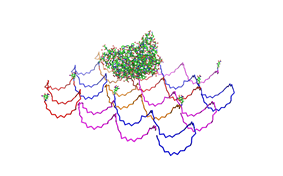Origami-DNA
From 2008.igem.org
| Line 9: | Line 9: | ||
As the antigens NIP and fluoresceine can as well be fused to these oligos, we had found the seemingly perfect tool to present strictly defined two-dimensional antigen-patterns to cells carrying our synthetic receptor system. | As the antigens NIP and fluoresceine can as well be fused to these oligos, we had found the seemingly perfect tool to present strictly defined two-dimensional antigen-patterns to cells carrying our synthetic receptor system. | ||
[[Image:Freiburg2008_Fab_on_Origami_animated.gif|800 px]] | [[Image:Freiburg2008_Fab_on_Origami_animated.gif|800 px]] | ||
| - | + | [[Image:Freiburg2008_NIP_arrangement_schematical.jpg]] | |
==Literature== | ==Literature== | ||
*Paul W. K. Rothemund: Nature 440, 297-302 (16 March 2006) | *Paul W. K. Rothemund: Nature 440, 297-302 (16 March 2006) | ||
}} | }} | ||
Revision as of 20:02, 23 October 2008
|
_DNA-Origami
IntroductionPaul Rothemund has discovered that it is possible to shape M13-Phage single-strand-DNA simply adding oligonucleotides that will work as „brackets“ when complementing the long single-strand. Literature
|
 "
"

